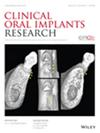Patient‐Reported and Clinician‐Reported Esthetic Outcomes at Implant Sites Are Not Associated: A Systematic Review With Individual Participant Data Meta‐Analysis
IF 5.3
1区 医学
Q1 DENTISTRY, ORAL SURGERY & MEDICINE
引用次数: 0
Abstract
ObjectivesThis systematic review aimed to determine whether patient‐reported outcomes (PROs) are associated with clinician‐reported outcomes (ClinROs) in terms of esthetics in patients with single implant‐supported crowns in the esthetic region.MethodsA systematic electronic search was conducted following a pre‐established protocol to identify randomized controlled trials (RCT) involving patients with single implant‐supported crowns in the esthetic region. Studies had to assess both patient‐ and clinician‐reported outcomes. A two‐stage individual participant data (IPD) meta‐analysis was conducted. First, each study was analyzed separately to obtain correlation coefficients. Second, these estimates were pooled using a random‐effects restricted maximum likelihood (REML) model.ResultsA total of 29 RCTs evaluating 1414 implant‐supported crowns were included, with IPD available for 14 trials evaluating 675 patients. At crown insertion, IPD meta‐analysis from 171 patients across four RCTs showed no significant correlations (患者报告和临床医生报告的种植体部位的美学结果不相关:一项系统评价与个体参与者数据荟萃分析
目的:本系统综述旨在确定患者报告的结果(PROs)与临床医生报告的结果(ClinROs)在美观区使用单种植体支撑冠的患者的美学方面是否相关。方法根据预先制定的方案进行系统的电子检索,以确定涉及美学区单种植体支撑冠患者的随机对照试验(RCT)。研究必须评估患者和临床医生报告的结果。进行了两阶段个体参与者数据(IPD)荟萃分析。首先,对每项研究分别进行分析,得到相关系数。其次,使用随机效应限制最大似然(REML)模型汇总这些估计值。结果共纳入了29项随机对照试验,评估了1414个种植体支撑冠,其中14项试验评估了675名患者。在冠插入时,来自4个随机对照试验的171例患者的IPD荟萃分析显示,粉红色美学评分(PES)与视觉模拟量表(VAS)评估的患者美学满意度之间没有显著相关性(r = 0.11, 95% CI [- 0.04; 0.27], p = 0.16)。在1年的随访中,11项研究中502例患者的IPD显示PES或改良PES与VAS审美满意度之间存在可忽略的正相关(r = 0.09, 95% CI [- 0.00; 0.18], p = 0.06)。在10年的随访中,两项研究中80例患者的数据显示改良PES和VAS患者满意度之间没有相关性(r = - 0.05, 95% CI [- 0.37; 0.27], p = 0.75)。关于白色审美评分(WES)和VAS满意度,7项研究中376例患者的数据显示1年随访无显著相关性(r = 0.03, 95% CI [- 0.08; 0.13], p = 0.60)。结论无论随访时间如何,临床医生报告的PES和WES结果与患者报告的审美满意度没有相关性。试验注册号CRD42023394920
本文章由计算机程序翻译,如有差异,请以英文原文为准。
求助全文
约1分钟内获得全文
求助全文
来源期刊

Clinical Oral Implants Research
医学-工程:生物医学
CiteScore
7.70
自引率
11.60%
发文量
149
审稿时长
3 months
期刊介绍:
Clinical Oral Implants Research conveys scientific progress in the field of implant dentistry and its related areas to clinicians, teachers and researchers concerned with the application of this information for the benefit of patients in need of oral implants. The journal addresses itself to clinicians, general practitioners, periodontists, oral and maxillofacial surgeons and prosthodontists, as well as to teachers, academicians and scholars involved in the education of professionals and in the scientific promotion of the field of implant dentistry.
 求助内容:
求助内容: 应助结果提醒方式:
应助结果提醒方式:


